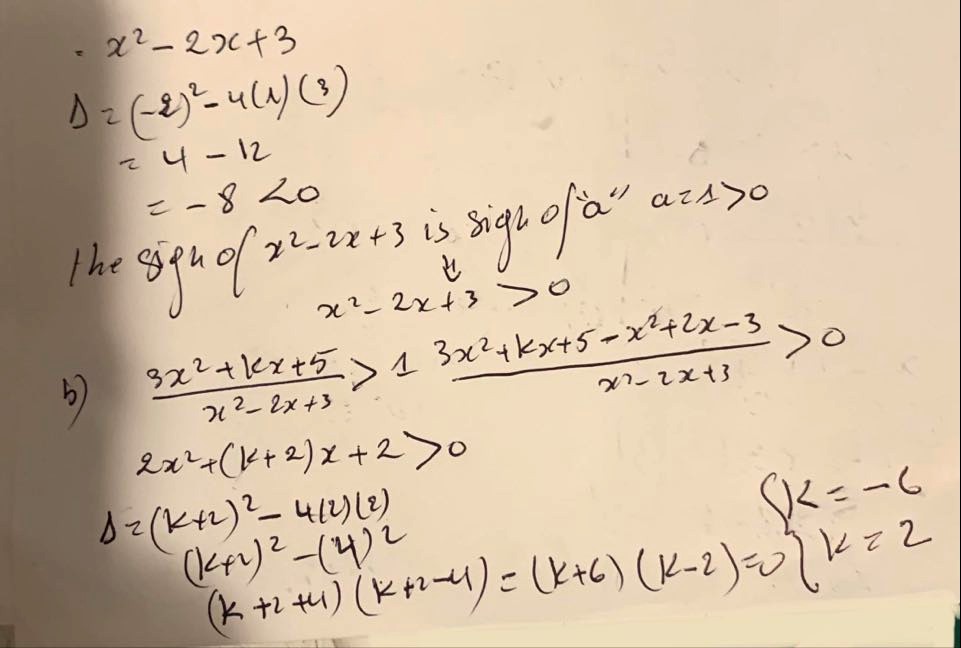Ask Singapore Homework?
Upload a photo of a Singapore homework and someone will email you the solution for free.

Question
secondary 4 | A Maths
One Answer Below
Anyone can contribute an answer, even non-tutors.

need help with b only, pls explain too
Normally for such equations with inequality sign, we cannot bring over the denominator (or you can see it as multiply both sides by the denominator) as we don't know its sign (whether it is negative or positive).
If the denominator is negative, we have to flip the inequality. If is positive we don't have to.
So if it's unknown, we can't bring over
But now, since it has been shown that x² - 2x + 3 > 0 for all real values of x, then now we can do so and we don't have to flip the sign.
(3x² + kx + 5) / (x² - 2x + 3) > 1
3x² + kx + 5 > x² - 2x + 3
2x² + (k + 2)x + 2 > 0
Now 2x² + (k + 2)x + 2 > 0 means that we want the part where y = 2x² + (k + 2)x + 2 is above the x-axis (where y = 0)
But since the coefficient of x² is positive , this is an upward sloping curve (U - shaped).
This means that for 2x² + (k + 2)x + 2 > 0, the minimum point of the curve (and all points above it) will always be above the x-axis and never intersect it.
So there will be no real roots for 2x² + (k + 2)x + 2 = 0
For such a case, the discriminant < 0. We are to find the value of k which satisfies this.
(k + 2)² - 4(2)(2) < 0
k² + 4k + 4 - 16 < 0
k² + 4k - 12 < 0
(k - 2)(k + 6) < 0
Now this is basically the equation of another U-shaped quadratic curve where the horizontal axis-intercepts are at k = 2 and k = -6
Since we want the portion that is below 0 (i.e negative) ,
-6 < k < 2
∴ Greatest integer value of k = 1
how to know whether its - 6
'-6 > x > 2 '
Think about it. How can x be bigger than 2 but smaller than -6, when 2 is already bigger than -6?
The above is suggesting that x is bigger than 2 BUT smaller than -6 at the same time.
You have to write it separately.
x > 2 or x < -6
You'll need to determine the shape of the curve based on the coefficient of x² first.
Positive coefficient means the curve is upward sloping (U-shaped)
Negative coefficient means the curve is downwards sloping (n-shaped)
Then, look at the inequality sign and determine if there is any intersection with the x-axis (where y = 0) or not.
Eg. for this question, for 2x² + (k + 2)x + 2 > 0 , positive coefficient of x² means it is a U-shaped of this graph and it has a minimum point.
For 2x² + (k + 2)x + 2 > 0 , this minimum point and all points above it should not have any intersection with the x -axis, if not there will be one real root or two distinct roots.
You want all points of the curve to have a y-coordinate higher than 0.
So discriminant < 0
It's not just looking at the which sign the inequality points to.
2x² + (k + 2)x + 2 < 0
Here, we want points on the curve that are below the x-axis (where y = 0)
But we know that since it is a U-shaped curve, it will definitely have to cut the x-axis at two points in order to have some part of the curve and the minimum point to be below the axis.
We can't have all points above it ,because then there would be no part that is below 0 (this is the case of no real roots for 2x² + (k + 2)x + 2 = 0
It cannot also be that the minimum point is the only one touching the axis since there are still no points below 0.
(this would be the case of 1 real root for 2x² + (k + 2)x + 2 = 0)
So, there will be two real roots and therefore discriminant > 0 .
(k + 2)² - 4(2)(2) > 0
k² + 4k - 12 > 0
(k + 6)(k - 2) > 0
The intercepts are k = -6 and k = 2, like the original question.
But this time, we want the portion that is above 0 (positive)
We know that since it is U-shaped, the minimum point and the portion between k = -6 and k = 2 is negative.
So since we want the portion that is positive,
Then k < -6 or k > 2
Likewise for the original question,
(k + 6)(k - 2) < 0
Here, you want the portion that is negative.
Since it is U-shaped, the minimum point and portion between k = -6 and k = 2 is negative,
Then -6< k < 2
Also, go to desmos.com and plot y = 2x² (k + 2)x + 2.
There will be a slider where you can adjust the value of k. Change it to see how the outcome of the graph varies.
You realise that for k = -6 and k = 2, the curve only touches the x-axis at one point. (At its minimum point)
For -6 < k < 2, (in between -6 and 2, or you can say 'bigger than -6 but smaller than 2')
the curve does not intersect the x-axis at all and it is always above it.
For k > 2 and k < -6, the curve always has two points of intersection with the x-axis, and the minimum point is below it. There are values for which the curve has negative y-values (below the x-axis)
as the maximum point must be below the x axis and it is a n-shaped curve, so the curve must lie below the x-axis. or am i wrong?
It is a n-shaped curve (∩) and since it is less than 0, its maximum point and all the points lower than that must be below the x-axis (where y = 0) .
So this means there is no intersection between the curve y = -2x² + (k + 2)x + 2 and the line y = 0 (effectively the x-axis)
If we try to solve for -2x² + (k + 2)x + 2 = 0, there are no real roots since there are no intersection points.
Discriminant < 0
(b² - 4ac < 0)
See 1 Answer
i.e (k - 6)(k + 2) < 0 and not
(k - 6)(k + 2) = 0
The discriminant < 0 as there are no real roots for 2x² + (k + 2)x + 2 = 0 , since it is > 0 from the previous part.





